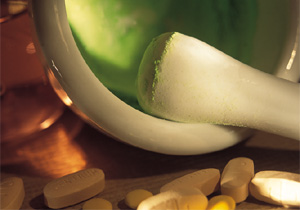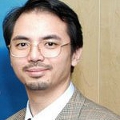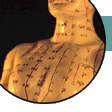|
 |
Introduction to TCM

Basics of TCM

• Yin-Yang | Five Elements

Zang-Fu Theories

• Zang Organs | Fu Organs

Classification of Antineoplastic Herbal Medicines

Characteristics of Herbal Medicines

Diagnose

• By Auscultation & Olfaction
• By Inspection

Prescriptions

Theories of Channels (Meridians) and Collaterals

Reference: A Modern View of the Immune System

Differentiation of Syndromes

• 8 Principles
• 6 Channels 4 Stages
• Syndromes of Zang-Fu Organs

Etiology

• Exogenous
| Pestilential
• Pathogenic Factors
• Emotional

Materia Medica


Back to Home

|
 |

The Six Fu Organs
Gall Bladder
The gall bladder is attached to the liver and stores
bile. There is an ancient saying regarding the close
relationship between the liver and bile, "The remaining
qi of the liver flows to the gall bladder and turns into
the juice of essence (bile)." Bile is continuously excreted
into the intestinal lumen to assist in digestion. The
bitter taste and yellow color of bile are significant
in disease manifestations of bitter taste in the mouth,
vomiting of bile, jaundice, etc. As the liver and the
gall bladder are externally and internally related, the
gall bladder is also involved in the free flow of qi
concerning emotional activities.
Clinically, when some mental disorders or emotional
symptoms such as fear and palpitation, insomnia, dream
disturbed sleep, etc. occur, treatment can be applied
by considering the gall bladder.
Stomach
Situated below the diaphragm, the stomach's upper outlet
connects with the esophagus, and its lower outlet with
the small intestine. Its main physiological function
is to receive and digest food. The stomach is also
known as the "sea of water and cereal." Food is
digested here, then sent downward to the small intestine,
where the essential substances are transformed and
transported by the spleen to the whole body. The
spleen and the stomach collectively are known as
the "acquired foundation," that is, their proper
nourishment establishes the foundation for a
healthy life. Clinical diagnosis and treatment
place great stress on the strength and weakness
of the stomach and spleen qi. Generally, it is
considered that whatever kind of disease occurs,
if stomach qi is still strong, the prognosis will
be good. It is said, "Stomach qi is the foundation
of the human body. When there is stomach qi,
there is life. When there is no stomach qi
death will follow." Preserving stomach qi is
therefore considered an important principle of treatment.
Normal stomach qi descends. If it fails
to descend, symptoms such as anorexia, fullness,
pain and distension of the upper abdomen,
nausea, vomiting, hiccough, etc. will appear.
Small Intestine
The upper end of the small intestine connects
with the stomach, its main function being to receive
partially digested food from the stomach and further
divide it into clear and turbid. The small intestine
transfers the turbid residues to the large intestine.
The spleen transports the clean essential substances to
all parts of the body, and part of the water contained
in food to the urinary bladder. Therefore, if
diseased, the small intestine will not only affect the
function of digestion and absorption, but also lead
to urinary problems.
Large Intestine
The upper end of the large intestine is connected
to the small intestine by the ileocecum, and its
lower end connects to the anus. Its main physiological
function is to receive the waste material
send down from the small intestine and, in the process
of transporting it to the anus, absorb a part of its
fluid, and convert it into feces to be excreted from
the body. Dysfunction of the large intestine produces
the symptoms of borborygmus and diarrhea; if the fluid
is further exhausted, the symptoms will be constipation
and so on.
Urinary Bladder
The main function of the urinary bladder is to
store and discharge urine. It has an exterior
and interior relationship with the kidney. Pathologically,
if the urinary bladder has a dysfunction of qi,
dysuria or retention of urine will appear.
If its restrictive function is lost, there may be
excessive urination or incontinence of urine.
Sanjiao: The Body Cavities
Sanjiao (three areas of the body cavity) is
a general term for the three sections of the body
trunk. The upper jiao contains the heart and lung,
the middle jiao contains the spleen and stomach,
and the lower jiao contains the kidney and urinary bladder.
The following are the categories of function
as described by the Lingshu:
The function of the upper jiao is to act like
a fog; the function of the middle jiao is maceration;
the function of the lower jiao is to be an aqueduct.
Thus the heart and lung function is to distribute
qi and body fluid by a spreading and moistening action.
The spleen and stomach must digest, absorb, and
transfer the qi, blood, and body fluid transformed
from the essential substances; a similar process
to that of soaking in water to cause decomposition
and dissolution. The kidney and urinary bladder
function to transport fluids and water.
Pathological problems in any of the three jiao
will effect the organs located there.
|

|
|
|
|
|
 |

|
WHAT IS TRADITIONAL CHINESE MEDICINE?

Photo © Image DJ Image Dictionary
With over 3000 years of experience, Traditional Chinese Medicine (TCM) has
remain one of the many fascinating areas in ancient Chinese culture.
First known to be documented in the Yellow Emperor's Canon of Medicine,
TCM is believed to have been practised in as early as 475 to 221 B.C.
The field of working knowledge of TCM stretches from anything related to
general healthcare practice to the philosophy of the mind, the logic of life,
religion, and even to as far as cosmology and astronumerology. This is why
in order to thoroughly understand the concepts behind TCM, one must be
comprehensive in learning and embracing the Chinese culture as a whole.
Just as Douglas Hoff put it when he explained about accupuncture, "The systems
of TCM uses the concepts of elements and meridians and are completely immersed
in the Asian cosmology which takes shape through the religions." The meridian-brain mechanism,
the fundamental working concept of acupuncture, in which the pain block from the message
that the needle or burning cone of herbs gives to the point of stimulus,
was only found centuries later by the West through science and technology.
|
| |
|
MESSAGE FROM THE EDITOR – MARCH 2020
 Thank you for visiting this TCM and acupuncture information website.
If you have previously been to this website, you might have
noticed that some of the pages on ancient historical ideas and
holistic thinkings related to Chinese metaphysics are temporarily taken offline.
This is because I will be revamping the whole website and be moving
those information into a new \"Ancient Chinese Culture\" section
so as to reflect a more current perspective on the interpretation
of some of the fundamental concepts as well as to include
some of the latest information in the area.
But if you have just found this website for the very first time, I welcome you again and
wish you could find what you require and, hopefully, you could also be benefitted
from reading the articles I published on this website.
Thank you for visiting this TCM and acupuncture information website.
If you have previously been to this website, you might have
noticed that some of the pages on ancient historical ideas and
holistic thinkings related to Chinese metaphysics are temporarily taken offline.
This is because I will be revamping the whole website and be moving
those information into a new \"Ancient Chinese Culture\" section
so as to reflect a more current perspective on the interpretation
of some of the fundamental concepts as well as to include
some of the latest information in the area.
But if you have just found this website for the very first time, I welcome you again and
wish you could find what you require and, hopefully, you could also be benefitted
from reading the articles I published on this website.
Please be patient and do come and check out this website frequently as it's being revamped.
Raymond Cheng, PhD DPA FRSA FRSPH

March 28, 2020.
|

|
IMPORTANT NOTICE AND DISCLAIMER

 This website is published, edited and designed by Raymond Cheng,
and reflects only and only his personal views and opinions in his individual capacity.
The information available at this website is not intended
directly or by implication to either diagnose or treat any
medical, emotional, or psychological condition or disorder.
It is also not intended to create a physician-patient relationship
between you and I or between you and Wyith Institute™ and The Office of Dr Raymond K K Cheng.
The information here is not a substitute for advice and treatment provided
by your physician or by another healthcare professional.
It is always recommended that consultation with local healthcare providers
be obtained for any of your specific health or medical concerns.
Furthermore, any products that can be purchased (yet you can see I don't have much
to sell here) through advertisers' banners or through links to other websites
are not either explicitly or implicitly given any warranty or endorsement
by me, my colleagues, Wyith Institute™ or any of its associated businesses.
This website is published, edited and designed by Raymond Cheng,
and reflects only and only his personal views and opinions in his individual capacity.
The information available at this website is not intended
directly or by implication to either diagnose or treat any
medical, emotional, or psychological condition or disorder.
It is also not intended to create a physician-patient relationship
between you and I or between you and Wyith Institute™ and The Office of Dr Raymond K K Cheng.
The information here is not a substitute for advice and treatment provided
by your physician or by another healthcare professional.
It is always recommended that consultation with local healthcare providers
be obtained for any of your specific health or medical concerns.
Furthermore, any products that can be purchased (yet you can see I don't have much
to sell here) through advertisers' banners or through links to other websites
are not either explicitly or implicitly given any warranty or endorsement
by me, my colleagues, Wyith Institute™ or any of its associated businesses.
|

|
|

 This website is published, edited and designed by Raymond Cheng,
and reflects only and only his personal views and opinions in his individual capacity.
The information available at this website is not intended
directly or by implication to either diagnose or treat any
medical, emotional, or psychological condition or disorder.
It is also not intended to create a physician-patient relationship
between you and I or between you and Wyith Institute™ and The Office of Dr Raymond K K Cheng.
The information here is not a substitute for advice and treatment provided
by your physician or by another healthcare professional.
It is always recommended that consultation with local healthcare providers
be obtained for any of your specific health or medical concerns.
Furthermore, any products that can be purchased (yet you can see I don't have much
to sell here) through advertisers' banners or through links to other websites
are not either explicitly or implicitly given any warranty or endorsement
by me, my colleagues, Wyith Institute™ or any of its associated businesses.
This website is published, edited and designed by Raymond Cheng,
and reflects only and only his personal views and opinions in his individual capacity.
The information available at this website is not intended
directly or by implication to either diagnose or treat any
medical, emotional, or psychological condition or disorder.
It is also not intended to create a physician-patient relationship
between you and I or between you and Wyith Institute™ and The Office of Dr Raymond K K Cheng.
The information here is not a substitute for advice and treatment provided
by your physician or by another healthcare professional.
It is always recommended that consultation with local healthcare providers
be obtained for any of your specific health or medical concerns.
Furthermore, any products that can be purchased (yet you can see I don't have much
to sell here) through advertisers' banners or through links to other websites
are not either explicitly or implicitly given any warranty or endorsement
by me, my colleagues, Wyith Institute™ or any of its associated businesses.



 Thank you for visiting this TCM and acupuncture information website.
If you have previously been to this website, you might have
noticed that some of the pages on ancient historical ideas and
holistic thinkings related to Chinese metaphysics are temporarily taken offline.
This is because I will be revamping the whole website and be moving
those information into a new \"Ancient Chinese Culture\" section
so as to reflect a more current perspective on the interpretation
of some of the fundamental concepts as well as to include
some of the latest information in the area.
But if you have just found this website for the very first time, I welcome you again and
wish you could find what you require and, hopefully, you could also be benefitted
from reading the articles I published on this website.
Thank you for visiting this TCM and acupuncture information website.
If you have previously been to this website, you might have
noticed that some of the pages on ancient historical ideas and
holistic thinkings related to Chinese metaphysics are temporarily taken offline.
This is because I will be revamping the whole website and be moving
those information into a new \"Ancient Chinese Culture\" section
so as to reflect a more current perspective on the interpretation
of some of the fundamental concepts as well as to include
some of the latest information in the area.
But if you have just found this website for the very first time, I welcome you again and
wish you could find what you require and, hopefully, you could also be benefitted
from reading the articles I published on this website.